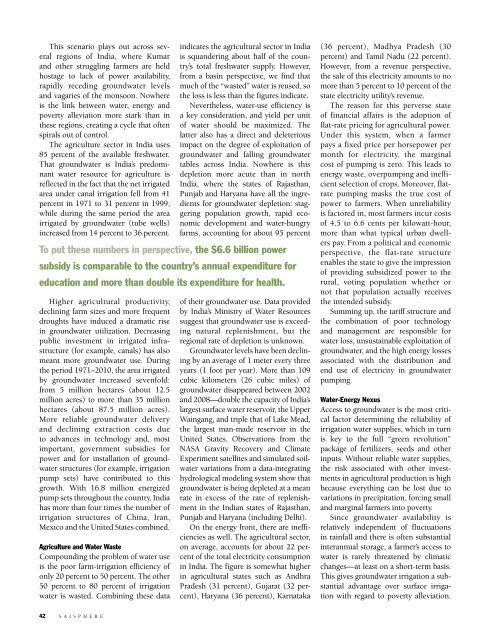Download Current Issue - SAIS
Download Current Issue - SAIS
Download Current Issue - SAIS
Create successful ePaper yourself
Turn your PDF publications into a flip-book with our unique Google optimized e-Paper software.
This scenario plays out across several<br />
regions of India, where Kumar<br />
and other struggling farmers are held<br />
hostage to lack of power availability,<br />
rapidly receding groundwater levels<br />
and vagaries of the monsoon. Nowhere<br />
is the link between water, energy and<br />
poverty alleviation more stark than in<br />
these regions, creating a cycle that often<br />
spirals out of control.<br />
The agriculture sector in India uses<br />
85 percent of the available freshwater.<br />
That groundwater is India’s predominant<br />
water resource for agriculture is<br />
reflected in the fact that the net irrigated<br />
area under canal irrigation fell from 41<br />
percent in 1971 to 31 percent in 1999,<br />
while during the same period the area<br />
irrigated by groundwater (tube wells)<br />
increased from 14 percent to 36 percent.<br />
Higher agricultural productivity,<br />
declining farm sizes and more frequent<br />
droughts have induced a dramatic rise<br />
in groundwater utilization. Decreasing<br />
public investment in irrigated infrastructure<br />
(for example, canals) has also<br />
meant more groundwater use. During<br />
the period 1971–2010, the area irrigated<br />
by groundwater increased sevenfold:<br />
from 5 million hectares (about 12.5<br />
million acres) to more than 35 million<br />
hectares (about 87.5 million acres).<br />
More reliable groundwater delivery<br />
and declining extraction costs due<br />
to advances in technology and, most<br />
important, government subsidies for<br />
power and for installation of groundwater<br />
structures (for example, irrigation<br />
pump sets) have contributed to this<br />
growth. With 16.8 million energized<br />
pump sets throughout the country, India<br />
has more than four times the number of<br />
irrigation structures of China, Iran,<br />
Mexico and the United States combined.<br />
Agriculture and Water Waste<br />
Compounding the problem of water use<br />
is the poor farm-irrigation efficiency of<br />
only 20 percent to 50 percent. The other<br />
50 percent to 80 percent of irrigation<br />
water is wasted. Combining these data<br />
42 <strong>SAIS</strong>PHERE<br />
indicates the agricultural sector in India<br />
is squandering about half of the country’s<br />
total freshwater supply. However,<br />
from a basin perspective, we find that<br />
much of the “wasted” water is reused, so<br />
the loss is less than the figures indicate.<br />
Nevertheless, water-use efficiency is<br />
a key consideration, and yield per unit<br />
of water should be maximized. The<br />
latter also has a direct and deleterious<br />
impact on the degree of exploitation of<br />
groundwater and falling groundwater<br />
tables across India. Nowhere is this<br />
depletion more acute than in north<br />
India, where the states of Rajasthan,<br />
Punjab and Haryana have all the ingredients<br />
for groundwater depletion: staggering<br />
population growth, rapid economic<br />
development and water-hungry<br />
farms, accounting for about 95 percent<br />
To put these numbers in perspective, the $6.6 billion power<br />
subsidy is comparable to the country’s annual expenditure for<br />
education and more than double its expenditure for health.<br />
of their groundwater use. Data provided<br />
by India’s Ministry of Water Resources<br />
suggest that groundwater use is exceeding<br />
natural replenishment, but the<br />
regional rate of depletion is unknown.<br />
Groundwater levels have been declining<br />
by an average of 1 meter every three<br />
years (1 foot per year). More than 109<br />
cubic kilometers (26 cubic miles) of<br />
groundwater disappeared between 2002<br />
and 2008—double the capacity of India’s<br />
largest surface water reservoir, the Upper<br />
Waingang, and triple that of Lake Mead,<br />
the largest man-made reservoir in the<br />
United States. Observations from the<br />
NASA Gravity Recovery and Climate<br />
Experiment satellites and simulated soilwater<br />
variations from a data-integrating<br />
hydrological modeling system show that<br />
groundwater is being depleted at a mean<br />
rate in excess of the rate of replenishment<br />
in the Indian states of Rajasthan,<br />
Punjab and Haryana (including Delhi).<br />
On the energy front, there are inefficiencies<br />
as well. The agricultural sector,<br />
on average, accounts for about 22 percent<br />
of the total electricity consumption<br />
in India. The figure is somewhat higher<br />
in agricultural states such as Andhra<br />
Pradesh (31 percent), Gujarat (32 percent),<br />
Haryana (36 percent), Karnataka<br />
(36 percent), Madhya Pradesh (30<br />
percent) and Tamil Nadu (22 percent).<br />
However, from a revenue perspective,<br />
the sale of this electricity amounts to no<br />
more than 5 percent to 10 percent of the<br />
state electricity utility’s revenue.<br />
The reason for this perverse state<br />
of financial affairs is the adoption of<br />
flat-rate pricing for agricultural power.<br />
Under this system, when a farmer<br />
pays a fixed price per horsepower per<br />
month for electricity, the marginal<br />
cost of pumping is zero. This leads to<br />
energy waste, overpumping and inefficient<br />
selection of crops. Moreover, flatrate<br />
pumping masks the true cost of<br />
power to farmers. When unreliability<br />
is factored in, most farmers incur costs<br />
of 4.5 to 6.6 cents per kilowatt-hour,<br />
more than what typical urban dwellers<br />
pay. From a political and economic<br />
perspective, the flat-rate structure<br />
enables the state to give the impression<br />
of providing subsidized power to the<br />
rural, voting population whether or<br />
not that population actually receives<br />
the intended subsidy.<br />
Summing up, the tariff structure and<br />
the combination of poor technology<br />
and management are responsible for<br />
water loss, unsustainable exploitation of<br />
groundwater, and the high energy losses<br />
associated with the distribution and<br />
end use of electricity in groundwater<br />
pumping.<br />
Water-Energy Nexus<br />
Access to groundwater is the most critical<br />
factor determining the reliability of<br />
irrigation water supplies, which in turn<br />
is key to the full “green revolution”<br />
package of fertilizers, seeds and other<br />
inputs. Without reliable water supplies,<br />
the risk associated with other investments<br />
in agricultural production is high<br />
because everything can be lost due to<br />
variations in precipitation, forcing small<br />
and marginal farmers into poverty.<br />
Since groundwater availability is<br />
relatively independent of fluctuations<br />
in rainfall and there is often substantial<br />
interannual storage, a farmer’s access to<br />
water is rarely threatened by climatic<br />
changes—at least on a short-term basis.<br />
This gives groundwater irrigation a substantial<br />
advantage over surface irrigation<br />
with regard to poverty alleviation.



